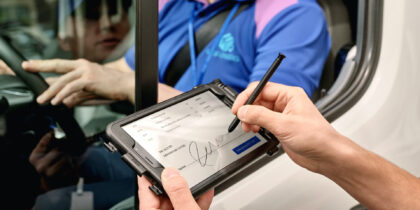As the electronic logging devices (ELD) mandate was working its way towards implementation, some industry experts predicted that driver productivity would decline by 10 percent, given the rigid regulation of hours of service (HOS). However, many fleets are finding ways to profit from the installation of onboard electronics, because ELD solutions have more to offer than just HOS recording.
The industry has indeed experienced a tightening of capacity due to the ELDs, but according to an analysis by FreightWaves, drivers are spending more of their time driving than they had been before the mandate. Two months post-implementation, drivers had increased their average midweek per-day driving time to seven hours, up from 6.52 hours before the ELD mandate went into full effect. Though it may seem like a marginal increase, it equates to an extra $54 per day in revenue for each of the 860,000 for-hire trucks operating today — a sizable total difference of $46.4 million in daily revenue.
Discipline Creates Capacity
The flow of data from ELDs is helping fleets improve their discipline by increasing productivity on the road and identifying shippers and receivers that waste drivers’ time. More than half of the drivers in a DAT survey said they spend three to five hours waiting to get loaded. Trucking companies typically offer two hours of waiting time and charge detention fees of $30 to $50 per hour after that.
With data from the ELD, fleet managers can see locations where trucks have to wait an unreasonably long time to load or unload, which reduces the driver’s available driving time. Fleets can also use the data to incentivize customer behavior, such as prioritizing service to locations that respect drivers’ time or imposing fees for wait times longer than the two-hour free period.
A number of larger fleets such as Schneider and Old Dominion had adopted ELDs or Automatic Onboard Recording Devices (AOBRD) prior to the 2018 deadline and had worked through any capacity constraints. Many fleets adopted in-cab ELD solutions using Samsung mobile devices for efficient fleet management. (Fleets still relying on AOBRD have until Dec. 16, 2019 to upgrade to ELD.)
Added Apps Drive Profitability
Fleets that use tablets to manage ELD can also deploy mobile apps to enhance performance, such as through route optimization. By creating routes with HOS restrictions in mind, fleets can minimize time lost to scouring truck stops for scarce parking spaces — a prominent challenge since the mandate took effect.
Your Roadmap for the Future of Fleet Management
Beyond ELD, learn how to transform the way you manage your fleet. Download Now
With ELDs, drivers are able to track their time down to the minute, compared to only 15-minute increments on the paper logs. Drivers can gain back driving time each day simply by leveraging that level of precision. Fleet managers can identify shippers and consignees that take too long to load or unload or cause other headaches for drivers. They can also identify those drivers that are the most productive in using their allotted driving time.
Using the data from the ELDs, fleet managers can effectively regain capacity without adding drivers or trucks by ensuring each truck is working as efficiently as possible.
Big Data Improves Fleet Performance
For carriers making the switch from paper logs, the fleet telematics capabilities of the ELD can provide new insights into their business. The ELD is wired to the truck’s engine, so it automatically records all engine-related events, including starting, stopping, acceleration and deceleration. Fleet managers can use this visibility to address fleet performance and control driving-related costs, such as fuel consumption. This can enable cost-saving measures that help offset any capacity lost to HOS compliance.
With ELD solutions, carriers can measure a variety of productivity metrics, such as mpg per driver, idle time and acceleration. Navigation data can reveal the most efficient routing to improve overall fleet utilization. Fleet managers can use this data to coach and train drivers to follow driving regulations and use driving techniques that save fuel and reduce wear and tear on the vehicles.
Fleet managers can use the analytics and tools to keep trailers full and on schedule, ensuring every mile is as profitable as it can be. Making the investment to run a more disciplined operation will pay off in the long run.
As the industry settles into the post-ELD era, fleets are moving beyond ELD compliance to capitalize on the power of fleet telematics. Those truckers who adapt to the new environment will improve fleet performance over the long haul.
See what connected fleet solutions are available to help you meet company and driver needs.









